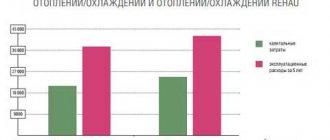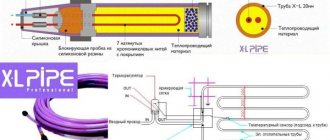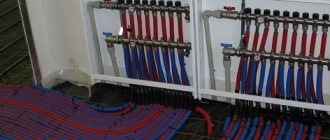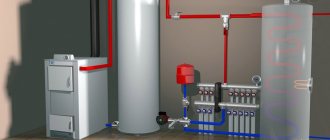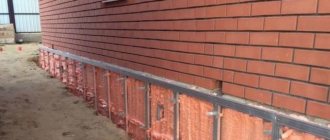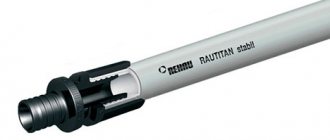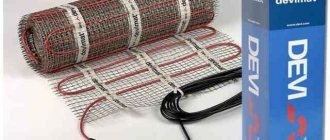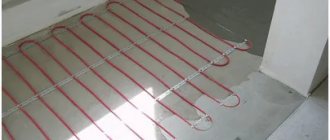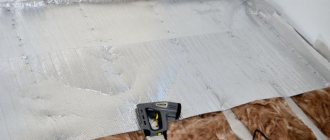Water heated floors Rehau
- Pipe for warm water floor Rehau - made using proprietary technology from cross-linked polyethylene. The sliding sleeve ensures easy and quick installation. Due to this type of connection, it became possible to quickly and reliably connect pipeline parts, and this, in turn, eliminated the need to use large pipeline coils. Rehau pipe diameter is from 17 to 32 mm. For comfortable use, the kit includes many fittings and fasteners. A red polyethylene pipe is a distinctive sign of this German brand.
- Rehau polystyrene foam mats for water heated floors. The buyer is offered a substrate for installing pipes of various designs: smooth and with Varionova clamps. There are also mats that allow installation on the mesh using harpoon staples or RAUFIX tires. You can install such a water floor yourself, since there is nothing complicated in the work itself, the fastenings are well thought out.
- The Rehau manifold for underfloor heating is made of stainless steel. The structure is fastened using galvanized brackets, which provide high sound insulation. The manifold includes control valves, some models have flow meters. The design of the comb is such that you can connect from 2 to 12 circuits. The operating principle of the German distribution manifold is based on a three-way mixing unit with a servo drive.
- An automation unit that controls the water floor, sensors and regulators. The pump-mixing unit, equipped with a servo drive, operates entirely in auto mode and precisely regulates the heating of the liquid. Temperature sensors are mounted between pipeline turns in a special corrugation, and this makes it possible, if necessary, to replace a broken device without dismantling the floor covering. The temperature control system can be controlled by mechanical and programmable devices. A distinctive advantageous feature of the units is the ability to control the thermostat using a remote control or the Internet.
- Various components and accessories. When purchasing a water heated floor system, you do not need to additionally purchase control and shut-off valves from other manufacturers. The consumer has access to both all the necessary fittings and plasticizers for Rehau brand screeds.
The manufacturer can guarantee the proper operation of the mixing unit and manifold only if the system is installed using components from the same brand.
https://youtube.com/watch?v=GHi70xb84TE
Other elements of Rehau water heated floors
In addition to the unique pipe, the Rehau company completes the heated floor with the following elements, some of which are also unique.
Varionova mats
This is a patented system for attaching underfloor heating pipes. Essentially, this is a mat with bosses for laying pipes according to design loops and patterns.
Varionova is suitable for laying pipes from 14 to 17 mm in diameter. Laying pitch from 5 cm. Available with or without a 30 mm insulation layer. Special clips are supplied for fastening mats without thermal insulation.
Collector
The Rehau water heated floor comes with its own 5 types of collectors:
- Manifolds HKV and HKV_D. Made of zinc-brass. Designed from 2 to 12 threads of underfloor heating. The second manifold has flow meters and high-speed taps on the supply line, and a control valve on the return line.
- UP: this is a cabinet for hidden installation, for example, under a layer of plaster.
- AP: surface-mounted cabinet. Five sizes.
- UP 75: concealed cabinet for underfloor heating systems (polystyrene or wood).
Insulation from walls
Branded Rehau products for isolating the system from the walls of the room.
How to choose electric heated floors?
So, we looked at a variety of electric heaters for floor coverings. Now let's look specifically at where it is best to lay them and under what floor coverings.
Which electric heated floor is best to use under tiles?
We cannot install an infrared film floor under the tiles in an apartment, despite all its advantages. Since it covers the entire area where tile adhesive will be applied with a continuous surface, it will not be possible to lay tiles on it.
Of course, there are film infrared floors with perforations supposedly to match the tiles, but it is better not to use them. There are far fewer good tilers than there are advertisements on Avito. The tiles can be laid haphazardly even without such a heater, but with such a film the contact with the glue will be even less and over time the tiles will begin to fall off.
Actually, by the method of exceptions, we came to the decision that a cable electric heated floor is needed under the tiles. Whether it will be on mats or just a heating cable depends on which heated floor is more convenient to install. If the area is flat, then, of course, the mats will be more convenient and faster to install; if your area is broken, then take the cable, not the mats.
If you have a question about the manufacturer, then I will not recommend any of them. I will only say that Russian manufacturers have stepped far forward and offer high-quality material with a guarantee of 30 years or more.
If you can afford to buy a German cable from a well-known manufacturer, then fine, no, don’t be upset. The performance of the floor will largely depend on how it is laid and, most importantly, that the heating cable is not damaged during the installation process.
Warm floors under laminate or linoleum, which one is better to choose?
And now it’s the turn of the infrared floor. The use of film heated floors under floor coverings such as laminate or linoleum is completely justified. This is explained by several points:
Firstly, the heating elements do not have to be placed in the screed, but rather placed directly under the laminate on a substrate with a reflective surface. This provides significant energy savings because There is no need to heat the floor slab, just the floor covering.
Secondly, laying an infrared floor is much easier from a technological point of view and almost anyone can handle it with a little repair skills and tools. In order to lay such a floor, it is enough to remove the old floor covering, lay the heating elements and put in a new one.
Thirdly, the use of infrared heated floors is beneficial from the point of view of rapid heating. If any other heated floor needs to warm up the screed, tile adhesive, etc., it takes quite a long time for the floor covering to warm up. The film floor will warm it up quickly, literally in 5-10 minutes.
Based on this, an infrared floor is best suited for coverings such as laminate or linoleum. It can be turned on only when it is really required and turned off when not required to save energy. You can get even more confused and install a programmable thermostat and set the time intervals for using such a floor.
Such a floor can be widely used on an insulated loggia. If you use it as an office or have exercise equipment there. Turned it on, worked, turned it off.
Another truly great advantage is its maintainability due to the fact that the heating elements themselves are relatively accessible and the least amount of labor (relative to other TP) is required to replace or repair them.
Characteristics of the electric floor "Rehau"
Warm floors "Rehau" are also available in electric models. In this case we are talking about the Solelec variety. The products are supplied with self-regulating two-core cables, a thermostat with sensor and an installation kit. Heating time does not exceed 2 hours. Heating costs are much higher compared to a water system. However, electric floors can be installed in apartment buildings, which will not affect the height of the ceilings.
If you want to choose a system with a minimum thickness, then you should prefer mats, while the cables are fixed to the mounting grid. Rehau warm floors are very easy to install; this is ensured by the elastic layer of the shell. Installation can be carried out even at temperatures below +5 °C, without losing flexibility. The heating element cores are reinforced with Kevlar, so they remain resistant to various loads.
The cable has a round cross-section, which simplifies the installation process. The manufacturer took care of increasing the service life by providing the heating cores with Teflon insulation. The cold cable is connected to the heating element by welding. Rehau heated floors in mats can have a minimum thickness of 2.8 mm. As for the length, it can be at least 2 m. The maximum value reaches 16 m.
The width starts from 0.25 m. If you want to choose a system based on area, you should know that this parameter can reach 8 m2. The cable thickness is 55 m, its length can vary from 10 to 120 m. Its minimum bending level is equivalent to 35 mm. Some craftsmen may also be interested in the cross-sectional area, it is 18 m2 maximum.
Warm floor Rehau (Rehau) Solelec
Rehau fittings (Rehau)The German company Rehau presents a new product on the Russian market - electric cable heating systems SOLELEC
.
Warm floor Rehau (Rehau) SOLELEC
is the ideal solution for installing a floor heating system in a modern home.
The Rehau SOLELEC underfloor heating system consists of:
- thermostat with temperature sensor
- heating cable or mat.
Thanks to the high quality of each component, thoughtfulness and ease of installation, reliable operation of the entire system is achieved for many years, without requiring additional care and maintenance during operation. The use of modern programmable thermostats makes it possible, at your request, to set the most comfortable room temperature during the day, allowing you to significantly save energy.
Temperature regulators Rehau (Rehau) Solelec
| Name | vendor code | Old price, rub. | New price, rub. |
| Thermostat Rehau (Rehau) Basic 10 A, with remote temperature sensor | 12108691100 | ||
| Thermostat Rehau (Rehau) Comfort 16 A, with timer function, with remote temperature sensor | 12274931100 | ||
| Thermostat Rehau Optima 10 A, with digital display, multifunctional, programmable, with temperature sensor | 12029231100 |
Rehau thermostat connection kit (Rehau) Solelec
| Name | vendor code | Old price, rub. | New price, rub. |
| Rehau thermostat connection kit (Rehau) Solelec | 13168311100 |
Heating cables Rehau (Rehau) Solelec
More information about heating cables Rehau (Rehau) Solelec
| Name | vendor code | Power (220/230 V), W | Old price, rub. | New price, rub. |
| Cable 2-core Rehau Solelec 8.86 m | 13168211555 | 150 | ||
| Cable 2-core Rehau Solelec 18.5 m | 13168221555 | 300 | ||
| Cable 2-core Rehau Solelec 31.04 m | 13168231555 | 500 | ||
| Cable 2-core Rehau Solelec 40.59 m | 13168241555 | 700 | ||
| Cable 2-core Rehau Solelec 49.35 m | 13168251555 | 850 | ||
| Cable 2-core Rehau Solelec 58.11 m | 13168261555 | 1000 | ||
| Cable 2-core Rehau Solelec 87.32 m | 13168271555 | 1500 | ||
| Cable 2-core Rehau Solelec 99 m | 13168281555 | 1700 | ||
| Cable 2-core Rehau Solelec 122.37 m | 13168291555 | 2100 |
Mats for underfloor heating Rehau Solelec
More information about mats for underfloor heating Rehau (Rehau) Solelec
| Name | vendor code | Power (220/230 V), W | Laying area, m | Old price, rub. | New price, rub. |
| Two-core mat Rehau Solelec 0.5×1 m | 13218991555 | 75 | 0,5 | ||
| Two-core mat Rehau Solelec 0.5×2 m | 13168111555 | 150 | 1 | ||
| Two-core mat Rehau Solelec 0.5×4 m | 13168121555 | 300 | 2 | ||
| Two-core mat Rehau Solelec 0.5×6 m | 13168131555 | 450 | 3 | ||
| Two-core mat Rehau Solelec 0.5×8 m | 13168141555 | 600 | 4 | ||
| Twin-core mat Rehau Solelec 0.5×10 m | 13168151555 | 750 | 5 | ||
| Two-core mat Rehau Solelec 0.5×12 m | 13168161555 | 900 | 6 | ||
| Two-core mat Rehau Solelec 0.5×14 m | 13168171555 | 1050 | 7 | ||
| Two-core mat Rehau Solelec 0.5×16 m | 13168191555 | 1200 | 8 |
Advantages of Rehau underfloor heating (Rehau)
- Rehau heating cables have a unique structure thanks to the use of the most modern scientific achievements and technologies using high-quality polymer materials;
- the sheath and insulation layer of Rehau cables are more flexible and elastic, which makes installation easier. When laid at temperatures up to +5°C, they do not lose their properties, i.e. do not become rigid when bending;
- the heating cores are additionally reinforced with Kevlar and can withstand both longitudinal and transverse loads;
- heating cores have additional Teflon insulation (FEP), which increases the durability of the cable;
- the cold cable is connected to the heating cable using the latest equipment at the factory by molecular welding;
- The cable is woven into a mesh of supporting material made of textile fabric with good wettability, and therefore, when pouring the solution, there are no air voids left (unlike mats secured with adhesive tape), which can lead to local overheating of the cable. The design becomes more reliable, and heat transfer is balanced and optimal;
- a one-piece mesh made of textile fabric, which holds the heating cable over the entire area, ensures reliable and high-quality installation when laying the mat;
- with possible longitudinal bending during installation, the horizontal plane of the heating mat is not disturbed, in contrast to the fiberglass mesh;
- when laying a mat with a cable in a mesh, in contrast to mats with adhesive tape, thanks to partial cuts of the mesh, additional flexibility is provided when avoiding obstacles (turns by 90°, 180°, turn by a semicircular arch, cut with half-loop folding and longitudinal shift or offset);
- A minimum mat thickness of 2.8 mm is possible, which ensures ultra-thin installation of heated floors! Mat widths are 0.25 m (for outdoor use), 0.3 m and 0.5 m;
- Rehau cables have a round cross-section (not oval), so they are easier to install;
- when preheated (connected to the network) before installation, they acquire additional flexibility, which allows them to be laid, for example, in a groove without additional mechanical effort.
Installation guide for Rehau heated floors
Why choose Rehau floors?
The floors of this German brand are known for their quality and long service life. The manufacturer offers its customers both water-based heated floors and electric-type coatings. Regardless of the specific model, rehau floors do an excellent job of heating the room, allowing you to maintain the most comfortable temperature for you and your household.
A distinctive characteristic of Rehau water heated floors is the use of cross-linked polyethylene pipes. These tubes are elastic and flexible, which greatly simplifies the installation process. Of particular importance is their resistance to external factors: the material can withstand high temperatures, is not afraid of impacts and does not corrode. The flexibility of the pipes allows them to be mounted on the base in any position without fear of kinks.
The electric version of the German underfloor heating system is distinguished by its small thickness. The material can be embedded directly into the tile adhesive layer. As a result of the work, the floor height will remain virtually unchanged, which makes it possible to use rehau floors in apartments with low ceilings. Installation can be done independently; the floor structure itself is accompanied by installation instructions and a set of components.
Rehau floors can be used as a basis for any decorative covering. You can use either carpet, laminate or tiles for finishing - the top decorative layer does not have any effect on the functioning of the Rehau floor.
How to install a Rehau underfloor heating system
Before installing a Rehau water heated floor, it is necessary to draw up a project, which includes calculating the system power for each specific room, and choose a pipe laying method - snail or snake.
Pipeline layout diagrams
The floor structure must be installed in such a way that temperature changes are not felt during operation. The optimal step is the distance between the loops equal to 11-18 cm.
Depending on the diameter of the pipe, the maximum length of the circuit should not exceed 120 meters. Otherwise, the coolant will reach the farthest sections of the pipeline already cooled, which will directly affect the quality of heating.
Overview of installation of heated floors using Rehau technology
Types, advantages and disadvantages of electric heated floors
In this case, electricity acts as the coolant. This is not a cheap fuel, but despite this, the heating system from the network has a number of advantages.
The advantages of an electric floor include the following:
- operation is possible in various conditions, whether the rooms are dry or with high humidity (swimming pools, saunas, etc.);
- if desired, the electric floor can be turned on even in summer;
- quick and easy installation;
- easy controls;
- does not require constant inspection and lasts for more than half a century.
Disadvantages of electric heated floors:
- It is desirable to have a thermostat, but if it is not there, then it is unprofitable to heat large areas from the mains.
- Presence of electromagnetic radiation. It may be small, but it is there. Radiation can be minimized using shielding braid.
You can read more about the effect of electric heated floors on human health here.
Electric underfloor heating can be presented in several varieties: infrared floor, mat system and cable system. Let's look at each type in more detail.
Two-core cable for heated floors
Warm cable floor. The design looks like a system of cables that consist of separate blocks. The blocks have a shielded cable with one or a pair of cores insulated with two layers. The cables are secured to each other with durable airtight sleeves. The design is made in such a way that it is absolutely safe for human health even in very damp rooms.
The “cable floor” system is economical, since the power of the cable used can be determined for different rooms.
Despite all the advantages of cable flooring, it does have a drawback. It consists of a mandatory screed, due to which the height of the floor will increase.
Warm floor in mats
Heating mats for heated floors. They are also represented by a cable system, only the cables here are thinner and they are secured to a mesh. They are produced in rolls and somewhat resemble rugs or mats (hence the name).
Their main advantage is ease of installation, which does not take much time. All that is needed to install the system is to roll out the roll and attach the cable to the socket on which there is a thermostat.
Heating mats are the best option for heated floors under tiles, since the tiles can be glued directly onto the mats.
Infrared heated floor. In this case, infrared film is used instead of cables. It operates on electricity, is mounted either under carpet or under laminate, and does not require a concrete screed.
Infrared heated floor
Once you install the infrared film, you can immediately connect and use it. After all, there is no need to wait until the glue hardens and the cement sets.
The advantage of infrared heated floors is the absence of dirt and dust during installation. It can be installed even in a newly renovated room and not worry about damage.
Infrared film can even be mounted on walls and ceilings, but it is worth remembering that this design is quite expensive.
Carrying out installation work
Regardless of whether you want radiator heating or heated floors, installation work involves a number of simple operations. Efficiency is ensured due to the fact that Rehau fittings are very functional.
The stages of installation work are as follows:
- Prepare all the necessary products and additional elements, make sure that they are free of any defects. Damaged parts will need to be replaced, otherwise problems may arise when operating the heating system.
- Separate the pipes into sections.
- If necessary, clean the ends.
- Place pipes where necessary.
- Secure the fittings.
- Assemble the products and fittings together using slide nuts.
- Tighten the nuts and make sure the pipeline is in good condition. It is necessary to check whether the system is working and whether anything needs to be fixed.
The procedures described above are standard - they are necessary in all cases. However, it is worth noting that when installing a heated floor you will have to spend more time than when working with radiator heating. The products will need to be laid in a spiral structure, but thanks to the flexibility of the pipes you can handle this very easily.
When carrying out installation work, connections can be welded or threaded. You can create even a very complex communication system, while the pipeline will be as strong and reliable as possible. These floors go very well with a wide variety of screeds. You don't have to worry about any emergency situations.
Operating principle of electric underfloor heating
The main working element is the heating cable. Unlike conventional electrical wiring, its resistance is higher. An electric current is passed through it, which causes the cable to heat up. In this case, heat is transferred to the concrete screed. For comfortable heating, the cable is equipped with a thermostat that maintains the set temperature by turning off the electricity after it has heated to the set temperature and turning it on again when it drops.
The heating elements of underfloor heating are very diverse:
- Single-core resistive cable. The heating core with a shielded sheath is made of nichrome, copper or brass. Heat is released evenly along the entire length when an electric current is passed. If heat dissipation in a local area of the floor surface deteriorates, the cable may fail due to overheating. Another disadvantage is the need to return the free end of the cable to the connection point. In this case, you have to do the entire installation of the heated floor yourself, which is a labor-intensive operation. Under a warm floor, the best installation is “snail” or “snake”. Combinations of these may be used. Single-core cable is chosen due to its low cost. After laying the heated floor, it is connected to the heat regulator and poured into the concrete screed.
- Two-core resistive cable. One shell contains two cores. It is easier to install a heated floor here, since returning the cable for connection is not required. It is enough just to short-circuit both wires at the end and protect the connection with insulation. They can both be heating, or one of them can only serve as a current conductor. Local overheating in such a cable can also occur.
- Self-regulating cable. It contains two parallel conductive wires with a semiconductor matrix placed between them, which is a heating element. When connected to voltage conductors, current flows through the matrix from one core to another in a transverse direction. The system is closed with an insulating shell and shielding steel braid. As the room temperature rises, the matrix resistance increases and the amount of heat generated decreases. There is no local overheating in a self-regulating cable, since the amount of current in any section depends only on its temperature. The price of such a cable is higher than resistive ones, but the service life is longer.
- Heating cable mat. According to the design, an electric cable mat is the same single-core resistive heater attached to a reinforcing mesh sheet. The installation consists of rolling out the heated floor roll on a flat base. Modern materials have an adhesive layer with which they are attached to the base surface. To rotate, the mesh is cut. After the laid heated floor is connected to a power cable and connected to a thermostat, and then laid in a screed or in an adhesive layer under the ceramic tiles.
- Carbon mat. The design consists of carbon heating rods connected in parallel to each other using two longitudinal insulated conductors. Thermal energy is released due to infrared radiation from the rods, transmitted to surrounding objects. The rods have the property of self-regulating heating. If one of them fails, the others continue to function normally. Infrared mats are laid under ceramic tiles.
- The heating principle is the same as that of infrared rods, but the heated floor is installed directly under the floor covering: laminate, carpet, parquet board, etc. Carbon heaters here are sealed in film and connected to film conductive busbars. Warm floors are sold in rolls and serve primarily to create additional heat.
Accessories for underfloor heating Rehau
The well-known German company for the production of polyethylene pipes Rehau also produces additional accessories that are designed for heating systems. These products include accessories for heated floors. The basis for the main line is the so-called mat (a plate with fixing ribs). The size of such a slab may vary (depending on the area of the room). It consists of elements that are connected to each other and form a continuous plane. The plate is made from foamed polystyrene. This elastic material is particularly durable and is not afraid of temperature changes. Some models have thermal insulation that reflects heat energy and directs it into the room without letting it escape onto the floor. If there is no such screen, then a special film is useful, which is spread under the mat. The entire system is designed for installation under the decorative layer of the floor (pouring screed and laying tiles). The spread of temperature to the walls is blocked using profiled wall insulation.
Accessories for Rehau underfloor heating are compatible with pipes from the same manufacturer. Recently, such a system has become increasingly popular among consumers around the world. The peculiarity of heating a room using heated floors is that it is not carried out by convection. That is, the heat that rises does not displace cold air towards the floor. This makes the top of the room cooler than the bottom. When using standard heating, the space near the floor does not warm up, which is why the feet of those living in the house are cold. Therefore, you need to turn up the heating more. As a result, hot air accumulates at the top of the room, making it difficult to breathe, and the bottom is still cold. With the Rehau underfloor heating system, this problem is eliminated. The feet of all visitors to the house are warm, and it is easy to breathe because the air in the room is fresh. This system has several advantages over its electrical counterpart. Firstly, there is no need to think through additional protection against electric shock. Secondly, water heated floors have high heat transfer. Thirdly, such a floor heats up faster, which significantly reduces the cost of heating the coolant. With the help of the presented devices for high-quality installation of the highway, even a beginner can cope with the task.
Characteristics and types of pipes
Pipes made of cross-linked polyethylene are divided into four groups according to the type of production:
- PEX-a - peroxide;
- PEX-b - silane;
- PEX-c - treated with fast electrons;
- PEX-d - nitrogen.
They are produced with diameters from 10 to 110 mm, operating pressure from 8 to 25 bar. They are designed to operate in a temperature range from 0 to 95 °C and do not react with acids and alkalis.
They are used in devices:
- warm floors;
- heating of domestic and industrial premises;
- cold or hot water supply;
- air conditioner piping.
They withstand freezing of the coolant without breaking connections, and quickly restore their previous dimensions after defrosting the water.
RAUTITAN pink
These are specially designed PEX-a pipes for creating heating systems in private homes and industrial premises. To protect against dissolved oxygen in water, an intermediate layer of ethylene vinyl alcohol is used.
RAUTITAN pink is used in pipelines with a working pressure of no more than 9 bar and a maximum temperature of up to 95 °C. For a short time, polyethylene pipelines will withstand an increase in coolant temperature up to 110 °C. Pipes with nominal bore diameters from 16 to 63 mm are produced, supplied in coils or individual six-meter pieces.
RAUTITAN his
Rehau Rautitan His 311
Rehau RAUTITAN cross-linked polyethylene pipe is used to supply hot or cold water to residential and industrial premises, and for piping process pipelines. It is produced from cross-linked polyethylene of the RAU-PE-Xa brand with the addition of peroxides under pressure. Produced with a nominal bore from 16 to 63 mm in coils or individual pieces up to 6 meters long and with wall thicknesses from 2.2 to 8.6 mm.
The use of this brand of polyethylene ensures stable operation of pipelines at an operating coolant temperature of up to 90˚C. It has a small thermal elongation of 0.15, has flexibility (bending radius is equal to 8 diameters), wear resistance, and a service life of more than 50 years.
RAUTITAN stabil
These pipes are used in heating and water supply systems. RAUTITAN stabil is a multi-purpose pipe with several layers. Between the inner and outer shells there is an intermediate protective aluminum layer. It plays the role of an insulator of the outer layer of non-crosslinked polyethylene from the diffusion of oxygen into it from water.
In water supply systems for drinking water, the pipelines must be designed for an operating pressure of up to 10 bar. In heating systems, RAUTITAN stabil pipelines are installed on lines with an operating pressure of up to 10 bar and a coolant temperature of up to 95˚C.
During emergency situations, it can withstand a short increase in water temperature up to 100 degrees Celsius.
RAUTITAN flex
Rehau Rautitan flex
RAUTITAN flex pipes supply hot and cold water, install heated floors, and use cast iron radiators or bimetallic radiators in rooms for heating.
The intermediate protective aluminum layer not only prevents the penetration of oxygen from water into the inner layers of cross-linked polyethylene, but also promotes better heat transfer. Therefore, these pipes are recommended for use when installing heated floors under: ceramic tiles, laminate, porcelain stoneware.
RAUTHERM S
RAUTHERM S pipe is used for installing heated floors. Due to its low price, a cross-linked polyethylene pipe with a diameter of 17×2.0 mm has become most popular among consumers.
The pipeline is protected from the penetration of dissolved oxygen from the intermediate layer of ethylene vinyl alcohol copolymer. Thanks to the three-dimensional internal structure, products made from cross-linked polyethylene are tear-resistant and do not form cracks throughout the entire period of operation.
The guarantee for the use of pipelines without breaking connections from exceeding the operating pressure by no more than seven times is 10 years.
Water heated floor Rehau “Rautherm S”
The Rautherm S integrated underfloor heating system takes its name from the unique pipe used in the system.
The RAUTHERM S heating pipe, otherwise called “Rehau red pipe”, is specially designed for heating systems and can withstand temperatures up to 90˚C for a long time.
Other advantages of the RAUTHERM S pipe include the high flexibility of the pipe, even at sub-zero temperatures, as well as high chemical, abrasive and mechanical resistance.
This pipe is suitable for carrying not only water coolant, but also antifreeze.
These pipe capabilities are achieved due to the material used. Pipes are produced from high-pressure cross-linked polyethylene (PE-Xa).
Pipes that have passed certification in Russia have sizes of 10 mm, 14 mm, 17 mm, 20 mm and 25 mm in diameter. Pipes are sold (supplied) in coils.
Let us immediately pay attention to the installation characteristics of the RAUTHERM S pipe:
- The minimum bend radius is equal to five outer diameters of the pipe itself. For example, a pipe with a diameter of 14 mm can be bent to a minimum radius of 7 cm.
- Installation of the pipe is possible at a temperature of minus 10˚C, which is convenient in new houses without heating.
- This pipe is thin-walled and, in terms of its throughput parameters, replaces thick-walled pipes of larger diameter. For example, a RAUTHERM S pipe with a diameter of 14 mm corresponds in terms of throughput to thick-walled pipes of 16 mm. For installation, this means saving on material without losing the characteristics of the heated floor.
- The pipe is connected to the movable sleeve in three simple steps. The result is a guaranteed tight connection suitable for filling with screed.
What types of warm electric floors are there: differences between a cable system and a film system
Cable heated floor.
This type of electric heated floors involves the presence of heating sections, mats and cables.
An electric heating cable is installed into the floor device, to which electricity is connected through a thermostat. Externally, the cable is similar to a regular one, but it is necessary to convert electric current into heat
At the same time, an important technical property of heating cables that is worth paying attention to is the power output per unit cable length. A heating cable is somewhat similar to a heating element
Sections of the cable floor are installed in a cement-sand screed, and heating mats are installed in a layer of tile adhesive on the old screed. In sections and mats of such a warm electric floor system, two types of cable are used: single-core or two-core. When laying a single-core cable, both ends must be returned to one point, but when installing a two-core cable, the second end of the cable does not need to be returned to the starting point.
Film heated floor.
The difference between this type of heated electric floor is that it uses a special film as a heating element. There are two types of film flooring: carbon and bimetallic.
The carbon floor is a resistive element mounted between two layers of Mylar film. The heating film is easy to install, so it can be used both as main and additional heating. It is allowed to be laid even under temperature-sensitive coatings (laminate, carpet). In this case, no special screed filling is required.
Installing a film electric heated floor with your own hands is easy to do even during cosmetic repairs.
Bimetallic flooring is a thin film of polyurethane, inside of which there is a two-layer compound. The bottom layer is an aluminum alloy with additives, and the top layer is a copper alloy (also with additives).
The film is rolled into a roll, divided into square sections (0.58 m x 0.54 m) that can be cut. Structurally, they consist of an open current-carrying bus, which is located at the edges and connected by a zigzag conductor 1 mm thick and with a pitch of 1 mm.
As shown in the photo, the film of such an electric heated floor is suitable for installation under decorative coverings (carpet, laminate, linoleum):
However, this film is not intended for installation under ceramic tiles. The recommended temperature on the thermostat is 27 °C.
Below we describe what other heated electric floors are available and what are their differences.
Cable networks
Electric heated floors require the use of a cable. It is also laid throughout the room and filled with cement screed. The cable used in such cases is safe for humans. It has a copper reflective layer that does not allow electromagnetic radiation to pass through. Such protection allows installation in any room, including children's rooms. It is also worth mentioning the Teflon insulation. It prevents the wire from heating and moisture from penetrating the heating elements.
Unlike a water circuit, an electric warm circuit provides:
- Automatic heating regulation.
- Dynamic warm-up if necessary.
- Setting different temperatures for each area.
Rehau cable can be combined with any finishing layer. It can be laid under wood, laminate, tile, linoleum and other materials. If you cannot make a cement screed in your room, you can use electrical elements in the form of ready-made sections. Their only drawback is the impossibility of dividing into fragments for installation on an area of complex shape.
In our store there are different models of warm circuit. You can buy thermostats, cables or ready-made mats with the required characteristics. All products are made in Germany and have a manufacturer's warranty.
Warm floor as the main heating system
If you wish, you can completely abandon classical heating in favor of heated floors. Hydraulic systems are better suited as the main heating system.
The main requirements in a heating system using underfloor heating are to warm up the entire room to the required temperature of 20-24 degrees. In this case, it is necessary to take into account the unevenness of heat loss in the room through external walls, window openings and ceilings. For such tasks, electric floors are somewhat inferior to hydraulic ones. With uniform heating, especially since areas with permanently installed furniture and household appliances should be left without electrical heating elements, cold bridges and areas with increased heat loss will inevitably appear.
By correctly distributing the water heated floor pipes with your own hands, you can achieve greater heat transfer under the external walls and reduce it closer to the inside of the room, where excessive heating is inappropriate.
Advantages of REHAU warm water floors
- Heating systems, underfloor heating, water supply and their installation
- /
- Professional installation, design, on-line underfloor heating calculator. Heating of street paths. Do-it-yourself warm floor. Information, installation examples
- /
- Warm water floor systems in private homes, industrial and sports facilities - information
- /
- Advantages of REHAU warm water floors
Warm water floor Rehau
is a system for heating and cooling surfaces used to create optimal temperature conditions in residential, office and industrial buildings, warehouses and hangars, as well as in outdoor and indoor sports facilities (for example, heating football fields). The main advantage of a warm water floor system from radiator heating is a more uniform and correct distribution of radiated heat.
Thermal comfort
Rehau
warm water floor system provides increased thermal comfort due to low-temperature radiant exchange.
Unlike traditional heating systems, when using Rehau
, an optimal microclimate in the room is achieved, which is expressed in the fact that the entire volume of air is evenly heated (when using radiator heating, the air is very hot near the radiators and is carried by convective currents throughout the room).
Economical
Rehau
water heated floors , in contrast to conventional radiators, allows the use of lower coolant temperatures when heating.
When heating rooms using Rehau
, the comfortable air temperature is 1-2 °C lower compared to using radiators. This is due to the fact that heat is supplied to the room in a distributed manner over the surface, and not from a local source (radiator). Each degree by which the coolant temperature decreases allows you to save up to 6% of energy costs. In addition to this, the saving effect is enhanced by the use of condensing boilers, which allow maximum savings to be achieved by lowering the coolant temperature.
Environmental friendliness
Due to their high heating output at low coolant temperatures,
Rehau
can easily be combined with condensing gas boilers, heat pumps or solar collectors.
Does not cause allergies
the Rehau
warm water floor system creates minimal air movement in the room. At the same time, there is no circulation of fine dust, which is gentle on the lungs, especially for people with allergies.
Does not dry out the air
Rehau
water heated floors is based on comfortable radiant heat; its use does not dry out the air, which often happens if conventional radiators are installed. Uniform heating of the air and reduction of convective flows eliminates the circulation of dust and the proliferation of microbes. This is especially important for those who suffer from asthma or allergies. The absence of complex mechanical equipment and a simple control system will allow you to easily regulate the temperature of your water heated floor.
Attractive design without heating devices.
Rehau
warm water floor system - allows you to freely arrange furniture - gives architects freedom of design decisions - reduces the risk of injury in kindergartens, schools, hospitals or nursing homes.
Temperature in the premises, according to GOST 30494_96, 12.1.005_88 - living quarters and rest rooms 18_24°C - bathrooms 18_28°C
Standard indicators of maximum indoor temperature - for sedentary activities 18_23°C - for non-sedentary activities 12_17°C - for offices 18_23°C - for baths 18_28°C - for bedrooms 18_24°C
Surface temperature for a warm water floor system:
Among all room enclosures, the floor occupies a special position because it is a contact surface, which is important for the thermal balance of the human foot. Here are limits for medical reasons that must be taken into account when designing and installing underfloor heating systems: - in areas of permanent residence 26 °C - for rooms or areas with temporary residence of people (border zones) 31 °C SNiP 41_01_2003
ISAN Company
offers the supply and installation of heated floors
Rehau
.
A heated floor system can be implemented in a city apartment or cottage. We also offer the Rehau
for heating open areas, paths and ramps.
More about the advantages of the REHAU underfloor heating system and the heating/cooling system in conjunction with a chiller
Go to the catalog section Water-heated floors REHAU
